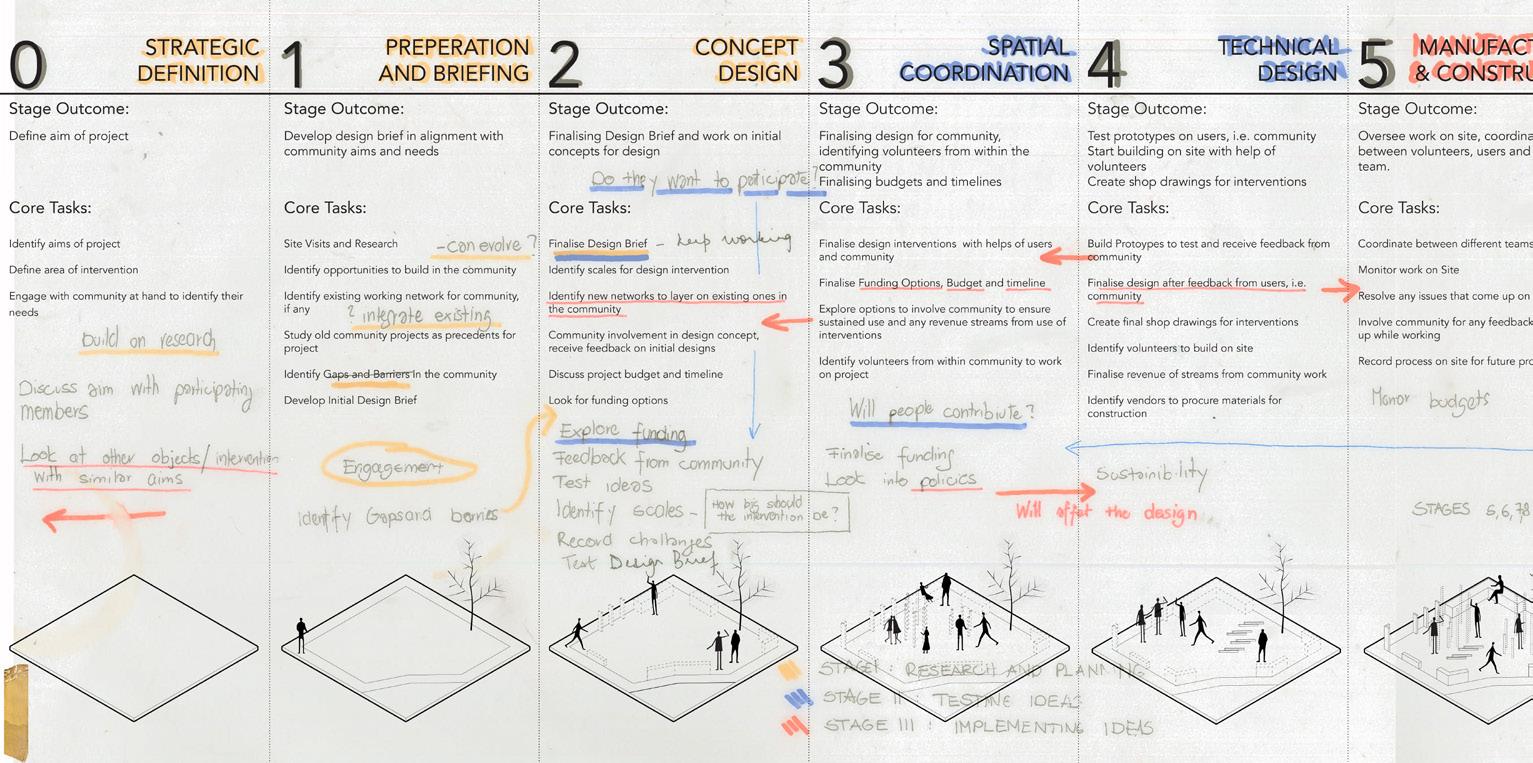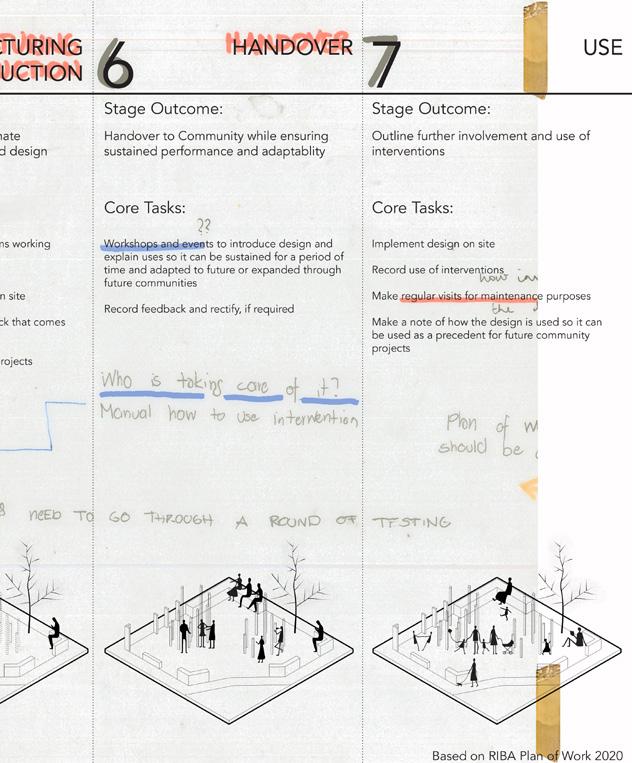
4 minute read
2 PLAN OF WORK
What does it mean to design for the defined? What are the restrictions, and move away from our positions as community? And how do we conduct
CORETASKS
Advertisement
DefineIdentifyaimsofproject areaofintervention EngageStartProjectResearchandSiteAnalysiswithcommunityathandtoidentifytheir
Identifyaimsforprojectsandneedsofcommunity.
DEFINITIONSTRATEGIC STAGEOUTCOME
Egats 3
MANUFACTURING& CONSTRUCTION OUTCOMESTAGE coordinatesite,onworkOverseebetweenusers.andvolunteersteam,designTASKSCORE workingteamsdifferentbetweenCoordinateMonitor Siteonwork siteonupcomethatissuesanyResolveInvolveupcomesthatfeedbackanyforcommunityworkingwhileRecordprojectsfutureforsiteonprocesscycleprojectthroughbudgetMonitor
RIBA Plan of work provides architects with a tool to organize different stages of a building project throughout its life. Although, it might not be applicable to community projects seeking co-design principals to make the project for and by the community. In such projects a more cooperative, user friendly approach should be followed that may contradict with the somewhat patronizing point of view that RIBA Plan of Work suggests. As a result, we decided to alter this framework to provide a reference for designers and architects as professional facilitators intending to deliver small-scale community projects.
In order to design a new manual, we followed a critical approach towards the original Plan of Work as well as our altered version itself. Consequently, we tried to test the manual in the field, record every challenge carefully and edit and update the manual
Selection of the Plan of Work Pages based on our findings. We consider this project as a process, not a finished product; with a self-critical attitude to make room for more explorations and improvements within the limited time-frame of this project and beyond.
Andpreperation Briefing
TASKSCOREusersfromfeedbackonbasedbriefdesignFinalise interventiondesignforscalesFinalisetimelineandBudgetOptions,FundingExplore ensuretocommunityinvolvetooptionsExplore ofusefromstreamsrevenueanyandusesustained projecttoapplicableifinterventions, projectforconstraintsIdentify
OUTCOMESTAGEidentifyingcommunity,fordesignFinalising communitythewithinfromvolunteers timelines.andbudgetsFinalising
SPATIAL COORDINATION
Egats 2
Starting with RIBA Plan of Work as a base tool, we kept the general template and altered the stage outcome and core tasks’ content to include more community engagements in each stage and make it more compatible overall to cooperative, small-scale community projects. By testing out the updated version on the field, we realized that the stages are better implied to probability rather than certainty based on unique challenges and community feedbacks that each project may deals with.
The description of the stages (0-7) represented as a cycle
Small Scale Community Projects
the community? What does need to be what are the rules? How can we notice as outsider professionals to partners of the conduct a project like that?
A Manual For Community Builders
Therefore, we made the manual circular in the final edition and used a less certain language to describe the stages. These changes allowed us to emphasize on the flexibility and the possibility of overlaps between stages, making it more adaptable to different community projects’ variants. The circular manual illustrates that the project never ends, it’s a repeating cycle instead of a line with an ending point.
Based on the framework suggested by the new Plan of Work and limited time and resources we have as students, our project is structured into three main stages with overlaps at some parts:
STAGE I - ANALYSIS
Small Scale Community Projects
Finally, after including co-design tasks based on Pablo Sendra’s paper on codesign ethics 3 , we attempt to contact RIBA to present our suggestions for a more democratic and adjustable Plan of Work.
This plan of work describes the process undertaken to deliver small-scale community projects with the help of design interventions by putting together a Project Programme. The different stages identified serve as a guidance to present the work to the community and can be used as stages to plan a community project that is adaptable, and sustained over a period of time. The manual works solely as a guide in the hope that communities at large can use and build by and for themselves.
(based on RIBA Plan of Work 2020).
Scope Of Work
STAGE II - TESTING
Stage Boundaries
Stages 0-4 will generally be undertaken one after the other.
STAGE III - IMPLEMENTATION
Stages 4 and 5 will overlap in the Project Programme for most projects.
Stage 5 commences when the protypes have been tested and feedback from the users/and community has been incorporated.
Stage 6 starts with the handover of the project entirely to the community, from whereon they manage the project by themselves. They run it and develop ways and means to understand and expand it.
Stage 7 starts concurrently with Stage 6 and lasts for the life of the intervention. It may be adapted over time as the needs of the community evolve.
SMALL SCALE COMMUNITY PROJECTS
Facilitating the community in reaching their tasks and goals by using punctured architectural interventions, offering initial and sustained engagement. The guide is also aimes at invloving the community by transforming the members of community from merely users to stakeholders.
Make regular visits for maintenance
*Please Note: Stages 5,6 & 7 have not been tested at this time of the project, they are open to changes after they have been put through a round of testing.
*Please Note: Stages 5,6 & 7 have not been tested at this time of the project, they are open to changes after they have been put through a round of testing.
Make a note of how the design is used so it can be used as a precedent for future community projects

Stages 0-4 will generally be undertaken one after the other.
Stages 4 and 5 will overlap in the Project Programme for most projects.
Stage 5 commences when the protypes have been tested and feedback from the users/and community
HANDOVER performance and events to introduce so it can be sustained over elements and key aims so they can expanded through future and rectify,

In the initial stage of our project, we tried to gain a better understanding of the community’s social setting to define our positionality and level of intervention. By analysing the existing infrastructure, we subsequently evolved our design brief based on potentials within the community. Following the steps mentioned in the Plan of Work, we are now prepared to face new challenges and test our initial analysis and ideas in the field by engaging with the community and apply their feedbacks into the process.










